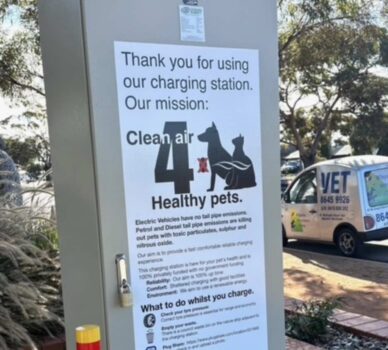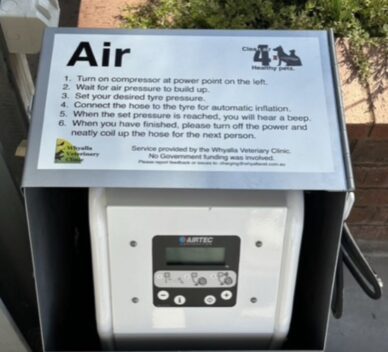Once again, timing is everything. The first fast DC charger in 1,550km between Madura in WA and Broken Hill in NSW quietly opened 5 days after we had trickled past using AC chargers on the way to Sydney.
Fortunately, we looked at Plugshare before heading back via the Eyre Peninsula in SA to discover that the Whyalla veterinary clinic now had a privately owned public fast DC charging station. We had to check it out!
Was it a mirage in arid outback SA? We pinched ourselves, but there they were – 75 and 50kW DC Tritium chargers, a supplemental 22kW AC outlet, a digital tyre pump, clear instructions, and all under complete sun cover in prime parking directly outside the entrance to the clinic, and opposite the main shopping centre, a few minutes walk away.
The EVansa app was easy to use first time, all plugs were CCS2 and both chargers were working. The signage and vibe from reception staff made it pretty clear that there was zero tolerance for being ICE’d. In short, it was a great charging experience.
What motivates a private organisation to provide such a good public service, using substantial capital with an uncertain return?
I was fortunate to speak with the vet, Dr Andrew Melville-Smith who is deeply committed to a renewable future and the welfare of his patients.
The business has been generating carbon offsets through Trees For Life since 2006, and electric transport was the next logical step to reduce emissions.

Andrew also wanted to abolish vehicle emissions which have a harmful effect on respiratory health in cats and dogs. We could only wish that our political class might one day become serious about applying this care to our children and grandchildren!
The clinic does all transport and patient transfers in four EVs, either the compact BYD Atto 3 SUV or larger Tesla Model Y SUV, both with LFP battery chemistry so staff can charge to 100% whenever needed without concerns about battery degradation. Andrew is planning solar PV on the clinic to reduce electricity transport costs to near zero.
Andrew initially planned for a 350kW charger but this was disallowed by SA Power Networks. The 75 and 50kW units are a small compromise of reliability over power, and are the latest generation from Tritium. He has ensured that a local electrician has been trained to service the units and is aiming for 100% reliability.
The EVansa app was chosen both for its ease of use and because it enables charging to generate verified carbon credits, currently the only one in Australia to do this.
The chargers run on 100% renewable energy through a power purchase agreement. The carbon credit is based on the difference in emissions between the EV and an equivalent sized ICE vehicle, all calculated in real time.
These credits are certified by an approved organisation and sold to private industry to help meet ESG plans. A straight carbon price would be so much simpler!
There is also need for scale and hopefully a higher price, as currently an average EV charging on 100% renewable energy for 12 months only generates around 2 credit units.
These chargers are in a vital spot on the Eyre Peninsula, which is quite EV unfriendly down to Port Lincoln, with long distances and bad headwinds.
It is a measure of Andrew’s commitment that he has privately filled an unmet public need without support of any kind from state and national motoring organisations or local government, despite bringing people and income into the town.
The signage made it very clear that there had been zero government funding. This was about the health of their patients as well as supporting decarbonised transport.

Many regional local councils in areas away from planned charging networks are still reluctant to install and maintain local chargers, citing cost and lack of demand.
While Andrew’s station is an exemplar of best practice, it shows what can be done by individuals and local communities. Even simpler, cheaper solutions like 32A plugs or lower power DC units can attract EV motorists who will spend money in the town while charging.
It is well worth the detour to charge in Whyalla. If you are passing, please drop in.
Chris is a retired medical specialist with a long term interest in renewable energy, but no particular knowledge or skills apart from curiosity. He and Juliet have lived in all electric houses powered by renewables for many years and purchased their first EV in 2021.
Read his recent articles:
Wind farms and solar towers as far as the eye can see: But where are the EV fast chargers
Long range trips in a standard range EV: How easy is it in Australia?

